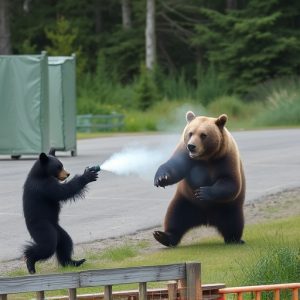Bear Spray Protection: Ingredients, Choice, & Safety Guide
Understanding bear behavior is key to safety in bear country. Bear spray, a specialized pepper spray…….
Understanding bear behavior is key to safety in bear country. Bear spray, a specialized pepper spray, uses chemicals like capsaicin (from chili peppers) and oleoresin capsicum (OC) to deter and repel bears by causing a strong reaction. The chemical composition of bear spray is crucial for informed safety decisions, effective deterrence, and correct usage. Users should inspect, store properly, practice target shooting, and employ prevention techniques for optimal protection during outdoor activities in areas inhabited by bears.
“In areas where bears roam, knowing how to prevent and respond to attacks is vital for safety. This guide explores bear attack prevention spray equipment, a key tool in safeguarding against potential threats. We delve into the science behind bear spray, its active ingredients, and how it repels these powerful animals. Understanding bear behavior and choosing the right spray for your needs are essential steps. Learn safe usage practices to ensure effectiveness and proper maintenance tips for your peace of mind.”
- Understanding Bear Behavior: Knowing Your Potential Threat
- The Science Behind Bear Spray: How Does it Work?
- Decoding the Ingredients: Unveiling the Chemicals in Bear Spray
- Choosing the Right Spray: Factors to Consider for Effective Protection
- Safety Tips: Proper Usage and Maintenance of Bear Attack Prevention Spray
Understanding Bear Behavior: Knowing Your Potential Threat
Understanding bear behavior is key when considering prevention methods, especially with equipment like bear spray. Bears are wild animals, and their actions often stem from instinct. They primarily avoid humans, but certain situations can trigger an aggressive response. For instance, mothers with cubs will fiercely defend their young, and bears may become defensive if they feel threatened or surprised. Knowing these behaviors allows individuals to take precautions when venturing into bear country.
Bear spray, a potent deterrent, is designed to stop an attack by irritating the eyes and respiratory system. It’s crucial to understand that different bear spray formulas have varying chemical compositions. Common ingredients include capsaicin, oleoresin capsicum, and various irritants derived from spices or peppers. These chemicals create a painful and unpleasant experience for the bear, encouraging it to retreat. Knowing what chemicals are in your bear spray can help you make informed decisions when choosing a suitable defense mechanism.
The Science Behind Bear Spray: How Does it Work?
Bear spray, also known as bear deterrent spray, is a specialized pepper spray designed for self-defense against bears. The science behind its effectiveness lies in the specific chemicals it contains, which work together to create a powerful deterrence. Key active ingredients often found in bear spray include capsaicin, oleoresin capsicum (OC), and various other synthetic compounds.
Capsaicin, the main component, is derived from chili peppers and is known for its burning sensation when encountered by the eyes, nose, or mouth. It triggers a powerful reaction in bears, causing them to recoil and flee. Oleoresin capsicum, another potent chemical, adds to the spray’s effectiveness by provoking an intense irritation response. These chemicals are usually mixed with a carrier agent like water or propylene glycol to ensure proper distribution and safe use. When sprayed towards a bear, this combination creates a protective barrier, discouraging aggressive behavior and providing crucial time for escape.
Decoding the Ingredients: Unveiling the Chemicals in Bear Spray
Bear spray, also known as bear attack prevention spray, is a crucial tool for hikers and outdoor enthusiasts navigating bear-inhabited areas. Decoding the ingredients of this potent defense mechanism reveals a complex blend of chemicals designed to deter and repel bears. The key active ingredient typically found in most bear sprays is capsaicin, derived from chili peppers. This substance stimulates the bear’s sensory organs, causing them to experience discomfort and potentially retreat.
Beyond capsaicin, other common components include various preservatives and surfactants. Preservatives ensure the spray’s longevity and stability, while surfactants aid in its distribution, allowing it to coat the target area effectively. Some advanced formulations may also incorporate ultraviolet (UV) stabilizers to protect against degradation from sunlight. Understanding these chemical compositions is essential for anyone looking to make informed decisions about their safety when venturing into bear country.
Choosing the Right Spray: Factors to Consider for Effective Protection
When selecting bear attack prevention spray, understanding what chemicals are in the formula is paramount. The most effective sprays contain capsaicin, a compound derived from chili peppers that irritates a bear’s eyes and nasal passage, causing it to deter and flee. Additionally, some products include natural elements like ultraviolet light or specific scents that can help identify when a bear is nearby.
Other factors, such as spray pattern, range, and weather resistance, also play significant roles in choosing the right equipment. A wide spray pattern ensures maximum coverage, while a long-range spray allows for distance safety. Weather-resistant cans are crucial for durability outdoors. Always consider your specific environment and activity level to ensure optimal protection.
Safety Tips: Proper Usage and Maintenance of Bear Attack Prevention Spray
Bear attack prevention spray is a crucial tool for hikers, campers, and anyone venturing into bear country. However, its effectiveness depends on proper usage and regular maintenance. It’s essential to understand what chemicals are in your bear spray to know its range, potency, and how it interacts with different environments. Typically, these sprays contain capsaicin, the same chemical that makes chili peppers spicy, along with other ingredients like water, propellants, and flavoring agents.
To ensure the spray’s optimal performance, users should follow safety tips. This includes regularly inspecting the can for damage or leakage, ensuring the nozzle is clear of debris, and storing the spray in a cool, dry place away from direct sunlight. Before using, practice target practice to familiarize yourself with its range and spray pattern. Remember, bear spray is meant for deterrence; always prioritize prevention through noise making, avoiding unpredictable behavior, and maintaining distance from bears.
Bear attack prevention spray equipment, with its unique blend of chemicals designed to deter bears (What Chemicals Are in Bear Spray), offers a valuable tool for outdoor enthusiasts navigating bear-inhabited areas. By understanding bear behavior and choosing the right spray, individuals can enhance their safety and enjoyment while exploring nature’s wilderness. Proper usage and maintenance are paramount to ensure these devices provide effective protection when needed.


